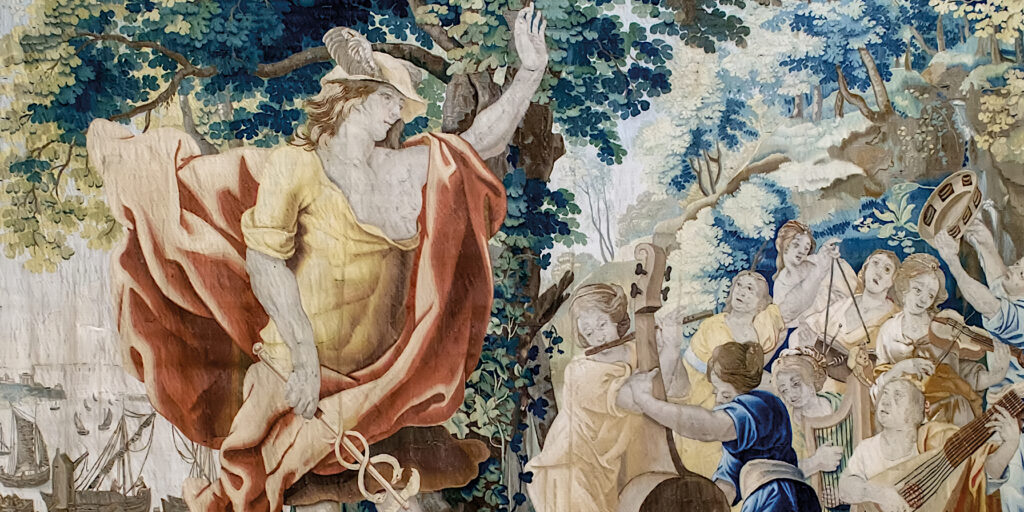Cultural Crossroads. Artistic Encounters between
the Low Countries and Spain, 15th-17th Centuries.
II- Woven Pictures
(Madrid, 8 November 2024)

* * *
Since 2020, the Moll Institute (Madrid) and the Périer-D’Ieteren Foundation (Brussels) have been conducting a research program aimed at identifying and studying the art that developed in the Low Countries from the 15th to the 17th centuries, which is still preserved in Spanish collections. As part of this collaboration, in 2023, a series of study sessions began to be held to share, deepen, and disseminate the work of specialists in the field. The 2023 study day took place in Brussels and focused on pictorial art. This time, the session will be dedicated to tapestries and will be held in Madrid.
Tapestries were top-tier luxury products that enjoyed tremendous success during the Early Modern period, both for their narrative and decorative possibilities. The quality of craftsmanship of these products by the workshops settled in the former Habsburg territories led to their popularity and demand growing to such an extent that leading artists were eventually enlisted to conceive the compositions that were transferred to the loom, further enhancing their interest and quality. The close relations that the Iberian Peninsula always had with the Low Countries facilitated the arrival of numerous series of tapestries to Spanish territory. Many of these works were commissioned by monarchs, important ecclesiastical figures, and nobles to the most prominent Flemish workshops. The different production centers, as well as the commissioning of series, the creation of cartoons, the various typologies of craftsmanship, their functions, and conservation, are topics we wish to address in this study session.
In Spain, highly significant collections of Flemish tapestries still exist, some of which are among the most prominent in the world, such as those housed by the National Heritage, which have been the subject of study by specialists in both specific catalogs and more general studies on the tapestries of the House of Austria. Likewise, exhibitions have played a prominent role in opening the door to new research. However, there are also numerous high-quality tapestries and series preserved in various dioceses of Spain, as well as in prominent noble families of the Iberian Peninsula, which are less known but open up a field of research of great interest.
The conference will be divided into various panels:
- Tapestry production in the Burgundian and Habsburg Netherlands. From tapestry guilds in the 14th century to the great workshops.
- Series and tapestries: Tapestry cartoons, artists, major commissions, and production for the art market.
- Function and valuation of tapestries in the Early Modern period. Tapestries in inventories of artworks.
- Restoration and conservation of tapestries. Challenges of a highly specific art form.
Papers may be delivered in English, French, or Spanish and will have an approximate duration of 15-20 minutes. The outcomes of the presentations will be subject to a publication in the Cahies d’étude series of Annales d’Histoire de l’Art et d’Archéologie, and the referenced works will be included in the database currently being created by the Moll Institute and the Périer-D’Ieteren Foundation.
Those wishing to participate in this study day should send, before June 7, 2024, a provisional title of their presentation and a short abstract of approximately 300 words, along with a brief CV, to the following addresses: congreso@institutomoll.es and fondation@perier-dieteren.org
The organizers will respond before August 31, 2024.
Please note that the organisers of the study day will not be able to cover accommodation or transport costs.
Organizers:
– Dr Ana Diéguez Rodriguez, Instituto Moll / Universidad de Burgos
– Dr Sacha Zdanov, Fondation Périer-D’Ieteren / Université Libre de Bruxelles
* * *
Selected bibliography:
K. Brosens, A Contextual Study of Brussels Tapestry, 1670-1770. The Dye Works and Tapestry Workshop of Urbanus Leyniers (1674-1747), Vlaamse Academie van België voor Wetenschappen en Kunsten, 13, Brussels, 2004.
T. P. Campbell (ed.), Art and Mafnificence: Tapestry in the Renaissance, New York-New Haven, London, 2002.
F. Checa Cremades and B.J. García (coords.), Los triunfos de Aracne. Tapices flamencos de los Austrias en el Renacimiento, Madrid, 2011.
S. Cortes Hernández, Tapices flamencos en Toledo: Catedral y Museo de Santa Cruz, Universidad Complutense de Madrid, 1992.
G. Demarcel and E. Duverger, Bruges et la Tapisserie, Bruges-Mouscron, 1987.
M. Díaz Padrón, Jacob Jordaens y España, vol. II, Barcelona, 2018, pp. 375-539.
M. Díaz Padrón, Jacob Jordaens and Spain, English edition, Instituto Moll, Madrid, 2019, pp. 371-535.
J.M. Ferrer González and V. Ramírez Ruiz, Tapices y textiles de Castilla-La Mancha, Guadalajara, 2007.
M. García Calvo, Tapices de Pastrana, doctoral thesis, UNED, Madrid, 1995.
A. García Sanz, “Rubens diseñador de tapices. Del lienzo al telar”, La grandeza de Rubens, Madrid, 2023, pp. 229-244.
Ghent 2008-2009: Tapices flamencos para los Duques de Borgoña, el Emperador Carlos V y el Rey Felipe II, Saint Peter’s Abbey, Ghent, 2008-2009.
E. Haverkamp-Begemann, The Achilles Series, Corpus Rubenianum Ludwig Burchard, vol X, London, 1975.
C. Herrero Carretero, Tapices de Isabel la Católica. Origen de la colección real española, Madrid, 2004.
P. Junquera and C. Herrero Carretero, Catálogo de tapices del Patrimonio Nacional, siglo XVI, vol. I, Madrid, 1986.
J. Matesanz del Barrio, R. J. Payo Hernanz, J. del Campo (coord.), Hilos de Flandes: la colección de tapices de la catedral de Burgos, Caja de Burgos, 2018.
K. Nelson, Jacob Jordaens, design for tapestry, Brepols, 1998.
Paris, 2010: Tesoros de la corona de España. Tapices flamencos del Siglo de Oro, Galerie de Gobelins, Paris, 2010.
Pastrana, 2010-2011: Las hazañas de un rey. Tapices flamencos del siglo XV en la Colegiata de Pastrana, 2010-2011.
N. de Poorter, The Eucharist Series, Corpus Rubenianum Ludwing Burchard, vol. II, Belgium, 1978.
V. Ramírez Ruiz, Las tapicerías en las colecciones de la nobleza española del siglo XVII, Universidad Complutense de Madrid, 2012.
G. Redín Michaus (dir.), Nobleza y coleccionismo de tapices entre la Edad Moderna y Contemporánea: las casas de Alba y Denia Lerma, Madrid, 2018.
VV.AA., Grand Design. Pieter Coecke van Aelst and Renaissance Tapestry, Metropolitan Museum of Art, 2014.
